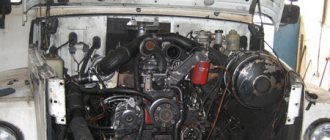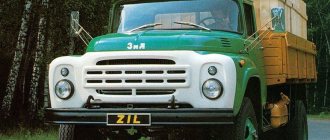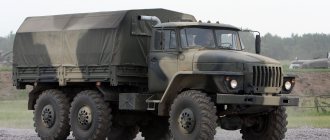gasoline consumption — Engine — Conference GAZ-69
gasoline consumption - Engine - GAZ-69 Conference Go to publication
alex_leonov 0
- Newbie
- More than a year in the club
- 0
- 16 publications
- City Novosibirsk
Vladimir 4
- Master
- Lawn workers
- 4
- 269 publications
- Gender:Male
- Name:Vladimir
- City:Moscow
- Interests:fishing, moto, auto, motorboats
Vladislav 546
- Master
- Lawn workers
- 546
- 1,097 publications
- Gender:Male
- City: Moscow region
- Interests:travel, fishing, GAZ 69
Venalich 1
- Master
- Lawn workers
- 1
- 316 publications
- Tula city
Said 2
- Motor mechanic
- Lawn workers
- 2
- 266 publications
- City:Kirov
- Interests:Photo, roads, off-road
Naikon 0
- Newbie
- More than a year in the club
- 0
- 1 publication
- Moscow city
- Interests:hunting
Alex 2 932
- Master
- Lawn workers
- 2 932
- 1,439 publications
- Gender:Male
- Name: Alex
- City: Zhukovsky
Vladislav 546
- Master
- Lawn workers
- 546
- 1,097 publications
- Gender:Male
- City: Moscow region
- Interests:travel, fishing, GAZ 69
Vyacheslav 7 213
- Master
- Lawn workers
- 7 213
- 2,811 publications
- Gender:Male
- City:G. Moscow.
- Interests: cars, food.
Alex 2 932
- Master
- Lawn workers
- 2 932
- 1,439 publications
- Gender:Male
- Name: Alex
- City: Zhukovsky
Hussein 0
- Amateur
- More than a year in the club
- 0
- 44 publications
Said 2
- Motor mechanic
- Lawn workers
- 2
- 266 publications
- City:Kirov
- Interests:Photo, roads, off-road
Dimochka 0
- Amateur
- Lawn workers
- 0
- 60 publications
- City Novosibirsk
- Interests: Gazooon! Sports, work, etc.
Said 2
- Motor mechanic
- Lawn workers
- 2
- 266 publications
- City:Kirov
- Interests:Photo, roads, off-road
hemozaur 1
- Master
- Lawn workers
- 1
- 188 publications
Victor Pavlovich 1
- Master
- Lawn workers
- 1
- 307 publications
- City: Lviv
- Interests: 4x4 car enthusiast
Talion 0
- Master
- Lawn workers
- 0
- 100 publications
- City: Amur region
- Interests:Computer, hunting, motorcycles
rtif2 0
- Amateur
- More than a year in the club
- 0
- 37 publications
SASHASHILL 98
- Master
- Lawn workers
- 98
- 1,500 publications
- Gender:Male
- Name: Alexander
- City:region 08
- Interests:AutoMotoantique, modernization, swap.
viktor57 3
- Master
- Lawn workers
- 3
- 258 publications
- Gender:Male
- Moscow city
- Interests:Hunting
www.gaz69.ru
Modernization and main modifications of the GAZ-69
A few months later, after the start of production of the GAZ-69, they began to be used in military parades, and in the spring of next year - in agricultural work. In 1954, many vehicles were used to service polar stations. By the way, it was precisely this step that motivated the designers of the Gorky plant to invent as many as 4 types of motor sleighs with tracks instead of wheels, using this “worker” as a basis. But even despite its wild popularity and seemingly impeccability, the car was often re-equipped and something new was introduced. So in 1960, the front axle was modernized, equipping it with reinforced bearings, pivot units and tighter cardan shafts.
Modification of GAZ-69-68 produced in 1970
The car underwent the most serious changes in 1968. Then the differential already had 4 satellites and became much more reliable, and also - the designers improved the braking system, equipping them with stiffer drums. New rims were installed on the front wheels, the headlights and shock absorber struts were slightly changed, a mass switch was added, the rear window was enlarged, and finally, the designers installed new awnings, and on the cargo-passenger version, additional windows. The modernization plan was completely completed in 1970 and the car received the index 69-68.
GAZ-46 MAV - Amphibious vehicle
During the entire production, along with the modernization of the GAZ-69 itself, many other military units were created on its basis, in particular, the 2K15 “Shmel” (missile system), GAZ-96рх (vehicle for radiation-technical reconnaissance), a prototype GAZ -19, GAZ-46 (floating vehicle), GAZ-011 (amphibious vehicle), R-125 “Alphabet” (staff vehicle for commanders), etc.
GAZ-69 all-terrain vehicle
Also, the GAZ-69 had quite a lot of modifications, which were widely used throughout the Soviet Union and were produced in fairly large quantities. These include:
- GAZ-69 – 8-seater 2-door SUV with an open body
- GAZ-69A – 5-seater 4-door agricultural SUV with trunk
- GAZ-69-68 - modernized 8-seater 2-door SUV with a tailgate
- GAZ-69A-68 - modernized 5-seater 4-door agricultural SUV with trunk
- GAZ-69E – 8-seater, 2-door with shielded electrical equipment
- GAZ-69M - export 8-seater 5-door car (engine capacity 2.432 liters, using 72 gasoline)
- GAZ-69ME - export version with shielded electrical equipment
- GAZ-69AM - export version with a 5-seater 4-door body
- GAZ-69AME - export version with 8-seater, 2-door body, tailgate and shielded electrical equipment
- GAZ-69P – police car
- GAZ-69B – rural postal vehicle
- GAZ-69 LSD – medical van
- GAZ-69 DIM - road induction mine detector (depth not less than 70 cm)
GAZ-69A "Shmel" (missile system)
Technical characteristics of "Truzhenik"
| Model | GAZ-69 | GAZ-69A |
| Years of manufacture | 1952-1972 | |
| Body | 8-seater 2-door open type, made of solid metal, with a tailgate and a folding awning | 5-seater 4-door open type, made of solid metal, with trunk and folding awning |
| Load capacity | 8 passengers or 500 kg cargo and 2 passengers | 5 passengers and up to 50 kg of cargo |
| Traction force | 850 kg | |
| Engine | Four-cylinder carburetor (Model - 20M) | |
| Cylinder arrangement, diameter | Vertical, 88 mm | |
| Engine capacity | 2.12 l | |
| Number of rpm | 3600 | |
| Power | 55 hp | |
| Average fuel consumption | 14l/100km | |
| Compression ratio | 6.5-6.7 | |
| Carburetor | Vertical falling flow, balancing type, equipped with economizer and accelerator | |
| Battery | 6ST-54 | |
| Clutch | Dry, single disc | |
| Transmission | Mechanical, three-stage, two-way | |
| Service brakes | Shoe blocks with hydraulic drive | |
| Parking brakes | Shoe with drum | |
| Steering gear | Globoidal with double roller and gear ratio 18.2 | |
| Maximum speed | 90 km/h | |
| Max. speed with trailer | 80 km/h | |
| Suspension | Leaf spring with double-acting hydraulic piston shock absorbers | |
| Weight | 1525 kg | 1535 kg |
| Curb weight | 2175 kg | 1960 kg |
| Dimensions d/w/h | 3850/1750/2030 mm | |
| Wheelbase | 2300 mm | |
| Overhang angle (front/rear) | 45/35 | |
| Tire size | 6,50 — 16 | |
| Tire pressure (front/rear) | 2/2.2 kgf/cm2 | |
| Fuel tank | 48L + 17L (optional) | 60 l |
Interesting Facts
Toy model GAZ-69 “Baby”
- This car became one of the main “heroes” of the film “Letters from Iwo Jima” (2006), where it played the role of a Japanese SUV of the Second World War. The plot of the film takes place on the island of Io.
- At the end of the twentieth century, Italian travelers made an extreme 2-year journey through the expanses of forgotten Africa in a GAZ-69 and UAZ-452.
- During the production of the GAZ-69, there was still no reusable coolant on the Soviet market, so drivers were forced to use water, and in winter, drain it daily at night.
- People liked to call this car a “goat.”
- Especially for the Artek pioneer camp, the designers produced the “Malyutka”, which was a fire pump for youth fire brigades.
- The Chinese company produced prefabricated construction toys of the GAZ-69, GAZ-69A and 2P26 models on a scale of 1:35.
- GAZ-69 and GAZ-69A were used in computer games such as Battlefield: Bad Company 2 Vietnam and Soldiers of Anarchy.
Tell me what to do with high gas consumption - Operation
Tell me what to do with high gasoline consumption - Operation - GAZ-69 Conference Go to publication
volga-step 0
- Newbie
- More than a year in the club
- 0
- 17 publications
- Gender:Male
- City: Astrakhan region, Enotaevka village
- Interests:hunting, fishing
Fedot68 3,237
- Master
- Lawn workers
- 3 237
- 6,581 publications
- Gender:0
- City:Kaluga
SkyLine34 0
- Amateur
- Lawn workers
- 0
- 80 publications
- Gender:Male
- City:Chishmy
- Interests:Motorsport
Anton-98 110
- Master
- Lawn workers
- 110
- 121 publications
- Gender:Male
- City:St. Petersburg
volga-step 0
- Newbie
- More than a year in the club
- 0
- 17 publications
- Gender:Male
- City: Astrakhan region, Enotaevka village
- Interests:hunting, fishing
Fedot68 3,237
- Master
- Lawn workers
- 3 237
- 6,581 publications
- Gender:0
- City:Kaluga
volga-step 0
- Newbie
- More than a year in the club
- 0
- 17 publications
- Gender:Male
- City: Astrakhan region, Enotaevka village
- Interests:hunting, fishing
Fedot68 3,237
- Master
- Lawn workers
- 3 237
- 6,581 publications
- Gender:0
- City:Kaluga
Artyom39 2 563
- Flea market moderator
- Lawn workers
- 2 563
- 2,449 publications
- Gender:Male
- City: Kaliningrad, historical homeland Moscow
- Interests: Versatile. +79212655101
Artyom39 2 563
- Flea market moderator
- Lawn workers
- 2 563
- 2,449 publications
- Gender:Male
- City: Kaliningrad, historical homeland Moscow
- Interests: Versatile. +79212655101
IgorS 0
- Newbie
- More than a year in the club
- 0
- 11 publications
ivv 0
- Newbie
- More than a year in the club
- 0
- 1 publication
ZveZreport 5
- Master
- Lawn workers
- 5
- 216 publications
- Voronezh city
- Interests:Cars
alexey-oren 229
- Master
- Lawn workers
- 229
- 263 publications
- Gender:Male
- Orenburg
GAZ-NE 0
- Newbie
- More than a year in the club
- 0
- 17 publications
- Gender:Male
- City:Novosibirsk, Nizhnyaya Yeltsovka
- Interests:hunting, fishing, jeeping.
www.gaz69.ru
Consumption - Operation - Conference GAZ-69
Consumption - Operation - GAZ-69 Conference Go to publication
beowulf 0
- Amateur
- More than a year in the club
- 0
- 26 publications
- Gender:Male
- City: Kirov, Kirov region.
[bn]santa 77
- Master
- Lawn workers
- 77
- 315 publications
- Gender:Male
- City Ufa
- Interests:Windsurfing
beowulf 0
- Amateur
- More than a year in the club
- 0
- 26 publications
- Gender:Male
- City: Kirov, Kirov region.
0
- Newbie
- More than a year in the club
- 0
- 1 publication
aleksandr77 122
- Master
- Lawn workers
- 122
- 274 publications
- Gender:Male
- Name: Alexander
- City:Khakassia
- Interests: alpine skiing, hunting
saoavia 3
- Master
- Lawn workers
- 3
- 362 publications
- Gender:Male
- City:Petrozavodsk
aleksandr77 122
- Master
- Lawn workers
- 122
- 274 publications
- Gender:Male
- Name: Alexander
- City:Khakassia
- Interests: alpine skiing, hunting
saoavia 3
- Master
- Lawn workers
- 3
- 362 publications
- Gender:Male
- City:Petrozavodsk
aleksandr77 122
- Master
- Lawn workers
- 122
- 274 publications
- Gender:Male
- Name: Alexander
- City:Khakassia
- Interests: alpine skiing, hunting
Gizmo701 0
- Newbie
- More than a year in the club
- 0
- 12 publications
- Gender:Male
- City: Danilov, Yaroslavl region.
vovanp 0
- Newbie
- More than a year in the club
- 0
- 2 publications
- Gender:Male
- City: Russia, Altai Republic
Fedot68 3,237
- Master
- Lawn workers
- 3 237
- 6,581 publications
- Gender:0
- City:Kaluga
Fedot68 3,237
- Master
- Lawn workers
- 3 237
- 6,581 publications
- Gender:0
- City:Kaluga
vovanp 0
- Newbie
- More than a year in the club
- 0
- 2 publications
- Gender:Male
- City: Russia, Altai Republic
NEIRON 0
- Amateur
- More than a year in the club
- 0
- 29 publications
- City:MOLDOVA
- Interests: HUNTING. TECHNIQUE
Grand59 0
- Amateur
- More than a year in the club
- 0
- 37 publications
- Gender:Male
- City:Perm
- Interests:GAZ-69, cars, active recreation,
Bobik 1
- Amateur
- Lawn workers
- 1
- 65 publications
- Gender:Male
- City:Samara City
Fedot68 3,237
- Master
- Lawn workers
- 3 237
- 6,581 publications
- Gender:0
- City:Kaluga
yurko-jeeper 0
- Newbie
- More than a year in the club
- 0
- 1 publication
- Gender:Male
- City of Lviv
Bobik 1
- Amateur
- Lawn workers
- 1
- 65 publications
- Gender:Male
- City:Samara City
Bobik 1
- Amateur
- Lawn workers
- 1
- 65 publications
- Gender:Male
- City:Samara City
www.gaz69.ru
GAZ-69 - the legendary Soviet jeep
In 1952, to replace the GAZ-67B military jeep, the Gorky Automobile Plant began serial production of a new jeep, designated GAZ-69.
The car had an eight-seater two-door open body covered with an awning. One passenger seat was installed next to the driver's seat, the rest of the passengers were placed on benches along the sides. The external design of the car was made in the style of American commercial vehicles of the forties, which distinguished the GAZ-69 from a number of domestic and foreign cars of similar purpose, which had bodies of an extremely simple design.
All components of the machine were mounted on a frame with closed-section spars and six cross members. The jeep was equipped with a GAZ-20 engine. All bridges are leading. The transmission includes a transfer case without direct drive. There was no center differential; the rear axle had a non-locking cross-axle differential. Bendix-Weiss constant velocity ball joints are installed. The suspension of all wheels is dependent spring.
In 1953, production of a five-seater modification of the jeep, GAZ-69A, began. The car had a four-door body and a passenger compartment layout similar to that used on conventional passenger cars.
The Gorky Automobile Plant produced cars of both modifications until 1956, when production of the GAZ-69/69A was transferred to Ulyanovsk.
The car was produced until 1972; in 1969 it was modernized - front and rear axles from the UAZ-452 light truck were installed on it.
The jeep served as the basis for the creation of a number of special army vehicles, in particular, the GAZ-69рх radiation and chemical reconnaissance vehicle and the 2P26 launcher for the 2K15 Shmel anti-tank missile system.
In the engineering troops, the vehicle was used to install a DIM road induction mine detector on it.
GAZ-69 was widely used in the Armed Forces of the USSR and was exported in large quantities.
| Width | 1750 mm |
| Height | 2030 mm |
| Wheelbase | 2300 mm |
| Rake bevel angle | 45 |
| Rear bevel angle | 35 |
| Weight | 1525 kg |
| Speed | 90 km/h |
| Max. power at 3700 rpm | 55 hp |
| Max. torque | 12.7 kg*m |
| Number of cylinders | 4 |
| Engine capacity | 2.12 l |
| Transfers | three forward, one reverse |
| Gear ratios | 1 - 3.115 2 - 1.772 3 - 1.00 reverse - 3.738 |
| Fuel reserve | 48 l main tank 27 l additional tank |
Fuel consumption Gas 69
We bought the car from a neighbor, who in turn brought a GAZ 69 from his brother. The car had been parked at the headquarters all its life under the radio, and on the second floor it had been dragged through the window by soldiers. A neighbor bought it as a write-off in 1989, and only drove it in the summer, to and from the dacha. Honestly, I was simply stunned by the quality of the metal of the GAZ 69 - everything is intact, a little rusty, this is the first impression. Further more - it starts with a foot starter, I’ve never seen it, everything is very specific, you won’t see much on other modern cars, but it’s very interesting, the engine is a lower valve, although they gave it a Volgovsky to boot, but how do you regulate the valves? There is not enough space inside; were there fewer people before? But I climbed in there (198 cm, 150 kg) only when the driver’s seat was overcooked, they tried very carefully so as not to spoil the spirit of the car, and the GAZ 69 has it. It starts halfway, but again very specific maintenance: there is a rough cleaning of the oil, the antifreeze does not hold, you need to pour water and drain it, God forbid the cold. Under the hood everything is very unusual, foreign cars are “resting”, the shock absorbers are some kind of lever type, this is the first time I’ve seen such things, but the neighbor said that they are “indestructible”. The gearbox is 3-speed, everything inside the body is very ascetic (it was hoped that the soldier should easily bear the burdens and hardships, although I don’t understand how he was supposed to press the pedals in tarpaulin boots; it’s hard for me in galoshes - I’ll definitely hit the wrong pedal) . The rear seats in the GAZ 69 recline along the sides; my father served in one of these. He said that this machine was carrying a 45 cannon, an artillery crew and a supply of shells. I won’t say anything about cross-country ability, it’s a pity to put my respected grandfather in the mud, there are younger cars. In general, the car is not for everyone, as far as I know - with spare parts there is a problem, there is no speed on the highway, in terms of cross-country ability, I think, at the level of an UAZ, in terms of comfort it is almost the same. If you take a normal car, it’s just for fun, although I’ll say it again, it’s not for everyone, although the GAZ 69 is quite capable of carrying all sorts of things to and from the dacha in our family.
More details at: avto-russia.ru
www.alfanoff.ru
A little history about GAZ-69
GAZ-69 is one of the first Soviet SUVs, which was produced from 1952 to 1972 and initially at the Moscow plant named after. Molotov. The same team that worked on the creation of the GAZ-67 worked on the creation of this model, namely: V. I. Podolsky, B. N. Pankratov, F. A. Lependin, G. K. Shneider, S. G. Zislin, V. F. Filyukov, V. S. Solovyov. The leader of the entire process was G.M. Wasserman.
Appearance of the GAZ-69 car
In fact, the history of this car began immediately after the war, in 1946, when the Gorky plant received an order to develop a worthy replacement for the GAZ-67B. It was supposed to be the same all-wheel drive passenger car, but with an improved engine, higher cross-country ability, more modern design and comfort. By the way, the resolution of the Council of Ministers of the USSR also clearly stated that an army tractor was needed to transport various cargoes, machine guns, ammunition and other things, with a total weight of up to 800 kg. Also, modifications without a trailer should go into production, which would be used for reconnaissance or movement of commanders. Despite the fact that almost all cars had some kind of development basis or prototype, the GAZ-69 was developed from scratch, only based on personal experience in using the American Willys and Bantam jeeps during World War II.
Appearance of the GAZ-69A car
In mid-autumn 1947, car designers presented the first prototype of the E-1, which was produced in three more copies over the next year. These cars were called “Truzhenik”, which directly meant not only their military purpose, but also their economic purpose.
Very often you can find the name both GAZ-69 and UAZ-69. This happened because a few years after the launch of mass production at the Gorky plant, this model was officially transferred to the Ulyanovsk Automobile Plant for production and, accordingly, the name of the car was changed.
Production of Soviet all-terrain vehicles
With the release of the first prototypes of the GAZ-69 (1948), it was immediately decided to put them into serious testing. The length of the route was 12.5 thousand km, and the entire process was led by the famous engineer A. Romachev. At that time, the car had very good characteristics - a high traction indicator (almost 70% of the total weight) with minimal speed damage, high ascent and descent angles (34 and 30 degrees) and good maneuverability through large layers of mud. As a result, the car successfully completed the specified path. A year later, the car was put into a more severe test, where the route consisted of complete off-road conditions, where the worst conditions were deliberately created. While the famous ZIS-151 got stuck in mud or snowdrifts, the GAZ-69 confidently overcame any difficulties. Neither 40 cm of snow, nor 30 cm of mud, nor ditches about 55 cm deep were an obstacle to it. At the beginning of 1950, the GAZ-69 passed another test, but this time for the safety of transportation in the air by military aircraft and gliders. In the same year, the fifth prototype was produced and sent to the test site. It was only in mid-1951 that all tests were completed and the vehicles were submitted for full inspection. As it turned out, all copies retained their functionality, their units remained intact and unharmed, there were no serious breakdowns, and the wear of parts was at a very low level. This completely satisfied the State Commission and the car received the green light for production.
Production workshop for assembling GAZ-69
The first large batch was released in 1953. Cars immediately began to be produced in two modifications - the army GAZ-69 and the agricultural GAZ-69A. The first 20 copies were immediately sent to Kazakhstan, where large export chains were soon established.
GAZ-69 had an open 8-seater body, which had a folding awning. It had two doors, was designed for eight passenger seats and had three rows of benches. While the GAZ-69A was more comfortable, as it was intended for personal use by officials. It had a 4-door, 5-seater body, which was additionally equipped with a trunk. Instead of benches, the designers equipped this car with soft seats.
Main dimensions
Beginning in 1954, both cars were simultaneously produced at the Ulyanovsk Automobile Plant, which was widely involved in the production of trucks during the war. But already in 1956, the Gorky Plant stopped production of the GAZ-69, giving all its powers to UAZ.
It is also interesting that more than half of the different parts of this car were taken from other, earlier GAZ models. For example, the designers borrowed the entire engine system, including the gearbox, brakes, ignition and stove from the GAZ-M20, and the handbrake, control devices and headlights from the GAZ-51. The new SUV received drive axles and tires from the GAZ-67B. But the features of the new model include: a rear axle with a non-locking cross-axle differential; transmission transfer case, in which there was no direct transmission; dependent spring wheel suspension, ball joints and two pairs of double-acting hydraulic shock absorbers. By the way, during the production period, individual structures of the Ministry of Internal Affairs of the Soviet Union gave individual orders for modifications to the car, or more precisely, to install a full metal roof instead of a folding awning.
GAZ-69A with a homemade metal top
Since 1970, the Ulyanovsk Automobile Plant began production of the modernized GAZ under article number 69-68. It had axles from the UAZ-452 military truck they had previously produced. Also, some modifications of the new GAZ were equipped with rocket launchers that were used to launch anti-tank missiles.
Over the course of 20 years, more than 600,000 copies rolled off the assembly line and about half of these cars were exported to many countries around the world. At the end of the 50s, UAZ designers granted the right to the Romanian automobile industry to mass produce the GAZ-69, officially transferring to them the necessary technical documentation. And starting in 1962, such a right was granted to North Korea.
GAZ-69 engine system
The engine for the GAZ-69 was taken from an older GAZ-20 car, namely a 4-cylinder carburetor. But since the new car was intended for more complex tasks, the designers slightly improved it, making it more powerful, economical and wear-resistant.
Car engine left
Based on sources, the previous GAZ-67B SUV consumed a lot of fuel, especially with a trailer or while driving off-road. In difficult conditions, this figure reached 0.4 l/ton-kilometer. While the new GAZ-69 under similar conditions consumed no more than 0.288 liters. Building on the old model, the designers also realized that the new car needed more power, so they decided to install a six-blade fan and an oil cooler to prevent engine overheating. The cylinder block was interchangeable with the engine block itself. As for the cylinders, they were cast iron and had a vertical in-line arrangement. In order to make them more durable, they were fitted with cast iron sleeves, 5 cm long and 2 mm thick. As practice has shown, it is thanks to the liners that the cylinders last 2-3 times longer. The cylinder block had water channels with cast iron valves (separate ones for each cylinder). This significantly improved the movement of the combustible mixture.
Car engine on the right
Two pairs of bearings were located at the bottom of the cylinder block, each of which was securely fastened with two bolts. On the other hand, the clutch housing is attached to the block. The overall cylinder head is made of aluminum alloy and is secured with 23 studs and washers. A special asbestos gasket, 1.5 cm thick, was placed between it and the cylinder block. By the way, asbestos could stick to the head and block over time, so the gasket had to be rubbed with a special graphite powder from time to time.
Also in the GAZ-69 there were 2 oil filters - a coarse filter (a set of special metal disks with slots and a sump) and a fine filter (designed to drain used oil into the crankcase). By the way, the air purifier itself was of the inertia-oil type, and the clutch consisted of a single disc. The three-speed manual transmission was a two-throw unit. The second and third gears had synchronizer. The main gear of the car was single and had a spiral tooth. The only difference between the current gearbox and the GAZ-M-20 gearbox is the location. Now it was located not near the steering wheel, but on the floor, to the right of the driver. In addition, due to the fact that the front axle hubs could be turned off, fuel consumption was slightly reduced. But, unfortunately, this only happened on perfectly smooth roads.
If you look under the hood of the GAZ-69, you can see a pre-start heating boiler on the left side. To warm up the car in severe frosts, it was necessary to first turn the steering wheel to the right and, using the hatch in the left front wheel, install a blowtorch in it. This way the oil in the crankcase was heated.
Exterior and interior of a Soviet SUV
As mentioned above, the body of the GAZ-69 was open and had a special awning, which was stretched manually. It was mounted on special rigid frames. By the way, the top of the doors had canvas covers that could be removed at any time. The window frame could be raised, so in the hot season this made the trip more comfortable. The hood had wide side panels that were also easy to remove, making it easier to operate the engine at high temperatures. The cabin was designed for 8 passengers: the driver and one passenger sat in front, then there were 2 rows of benches with 3 seats each. In fact, these benches served as boxes, since the seats were raised and various tools could be stored inside. The tailgate of the car was folding, and the space inside was used to store a cable, emergency signs and other accessories. There was a fine filter on the fuel pump, and a coarse filter on the frame.
Car interior - view from the driver's seat
In addition to the main fuel tank, a second, identical tank with ventilation was hidden under the front passenger seat. Yes, it was possible to refuel it only through the salon. Another nuance was that the instruments showed the driver only the amount of gasoline in the main tank. Gasoline in the additional tank was checked through the neck. The stove in the cabin only worked while driving and supplied hot air to the feet of the driver and all passengers. A stationary car could not be heated in any way.
Car interior - rear view
The agricultural modification of the GAZ-69A had a number of differences. First of all, this affected the body and interior, the seats in which were reduced from eight to five. In addition to the driver and front passenger seats, only one bench was installed at the back. Also, the car was equipped with a spacious trunk, which could be accessed even from the passenger compartment, and had only one fuel tank. In general, the appearance of both cars was typical of those times and had some similarities with the famous American jeeps.
Fuel consumption - Page 2 - Operation
1 hour ago, gazonchik1969 said:
with carb - check and bring into compliance (nozzle values, cleanliness, condition of mating and gaskets). carburetor repair (maintenance) - leisurely work on sealing (reducing) holes (where not necessary)) and cleaning, and selection (where necessary)). adjustments (significant) - level and XX (the essence is finishing work) are carried out - on a working carb. VF (modern) is required (for non-museums). py.sy. GTZ what date?? (if the carb is new, a check of the throughput is mandatory.. silyavi))
Today I unscrewed the spark plugs, look, maybe you’ll see something, I still don’t understand, the filter is clean, but it’s confusing where the breather comes out of the pan, there’s no hose underneath, the spout just looks down and there’s a deposit of oil on the top of the carburetor.
www.gaz69.ru
Foreign roots, pre-heater and hard top: myths and facts about the GAZ-69
MYTH 1: When developing the GAZ-69, a foreign prototype was taken as a basis
MYTH
There is an opinion that Soviet SUVs were created not just with an eye on foreign prototypes - the engineers of our factories almost made prototypes on someone else’s frame. American jeeps of those years (Willys MB), as well as Land Rover, invariably appear in conversations.
| It is appropriate to compare the legendary Willys with the GAZ-67, but not with the “sixty-ninth”, since the “goat” is larger, more spacious and more comfortable |
| The British SUV appeared almost at the same time as the Gazik. These cars were related more by concept than by design or technology. |
The fallacy of this opinion is shattered by the document from which GAZ began taking the new model seriously. After all, Decree of the Council of Ministers of the USSR No. 1118-325 and the subsequent order of the Ministry of Automobile and Tractor Industry No. 34 ordered Gorky engineers to create a new car with significant unification with the GAZ-20 Pobeda, including the engine and many transmission and chassis components. In fact, the frame SUV was supposed to be built on the components of a passenger car - of course, with the exception of all-wheel drive units.
| The low-valve engine from Pobeda, thanks to a two-stage transfer case, turned out to be a suitable unit for an SUV |
Therefore, not only the engine with the gearbox, but also the steering mechanism, shock absorbers, brakes, optics and battery for this car were taken from serial Soviet cars and trucks.
| The first prototypes of the new machine called “Truzhenik” were ready by the end of 1947 | |
Moreover, it was not our GAZ car that had a foreign prototype, but on the contrary - a foreign-made car was created on the basis of the GAZ-69! Indeed, in 1957, technical documentation for the GAZ-69 was transferred to Romania to the IMM plant without purchasing a license, and in 1962 - to North Korea. True, Romanian SUVs had a “foreign heart” - a 50-horsepower MAS gasoline engine.
1 / 5
2 / 5
3 / 5
4 / 5
5 / 5
Having produced only 2,000 copies in just over two years, the Romanians in 1959 created a modernized car with the M59 index, which differed from the “goat” in a four-speed gearbox and other axles. Five years later, in 1964, the car received a more powerful overhead valve engine. Interestingly, Romanian unlicensed copies even competed with the Soviet source in some foreign markets, because the GAZ-69 was exported to more than 50 countries around the world! The ARO-M461 was produced until 1975, outliving its original from the USSR by a couple of years.
| "Gazik" could be found in various corners of the globe |
MYTH 2: In terms of cross-country ability, the “goat” had no equal -
Truth
The GAZ-69 was conceived both as a light transport for military personnel and for agricultural workers, geologists and government employees working in rural areas. It is no coincidence that the prototypes bore the name “Truzhenik”, which for some reason did not catch on on production cars. Soon after production began in 1953, the “target audience” was able to appreciate the off-road potential, which commanded the respect of everyone who tested the small car in action.
1 / 4
2 / 4
3 / 4
4 / 4
Despite the passenger power unit, the “goat” could actually overcome a ford up to 0.7 m deep, and also confidently stormed thirty-degree climbs and slopes. The recipe, as in the case of the GAZ-67, turned out to be simple to the point of genius - high ground clearance (210 mm), short wheelbase, all-wheel drive and virtually no overhangs.
| The layout of the GAZ-69 was extremely utilitarian | |
But it worked so well only in combination with good weight distribution and well-chosen transmission numbers with a two-speed transfer case, which allowed the not-so-powerful car to literally work wonders off-road.
1 / 3
2 / 3
3 / 3
Moreover, the “sixty-ninth” could drive on dirt roads and rough terrain even a little faster than its predecessor, and the level of comfort (if this word is applicable here) was higher than in the GAZ-67.
| Know ours: in 1972, the Italian Luigi Martorelli, driving a GAZ-69, took first place in the rally for all-wheel drive vehicles! |
MYTH 3: At first the GAZ-69 was produced at GAZ in a two-door version, and then - only in a five-door version and in Ulyanovsk -
myth
The GAZ-69 was originally designed with a two-door, eight-seater body, in which the driver and passenger sat in the front, and the other six passengers sat on longitudinal benches in the rear. In the cargo version (with folded benches), the vehicle could carry up to 500 kg of cargo.
| A car with the GAZ-69 index could carry up to eight people, six of whom were located facing each other in the rear of the body |
However, a prototype of a more comfortable four-door, five-seater version of the GAZ-69A (body 77) appeared even before the state tests of the GAZIK, which took place from September to June 1951.
| Pay attention to the side windows of the pre-production GAZ-69A! |
| In the photo: serial GAZ-69A |
The cars differed not only in the number of doors and seats, but also in the location of the spare wheel. On the cargo-passenger version, the spare tire was mounted outside on the left side behind the driver's door, and on the five-door version it was located in the trunk. Also on the GAZ-69A there was one 60-liter tank, and on the two-door version there were two tanks (47 l and 28 l), with an additional tank of smaller capacity located under the front passenger seat, and to refuel you had to open the right door.
| One car, but two different bodies - GAZ took a creative approach to solving a difficult problem |
| The spare wheel for the two-door version was located outside the body... |
| ...and on the four-door GAZ-69A the spare tire was moved to the trunk |
| In Soviet times, a two-door gas car could be found in this form - without a spare wheel on the outside. Often the spare tire was simply thrown inside the body after a puncture. |
Serial production of the GAZ-69 and GAZ-69A in Gorky began in August 1953, and almost simultaneously (in 1954) the production of these cars was launched in Ulyanovsk - at the former UlZIS plant, renamed UAZ. At first, cars were assembled here from vehicle kits manufactured at the Gorky plant, but gradually the production of parts was established in Ulyanovsk.
| GAZ-69 was produced at two factories, but under one index |
GAZ produced SUVs until 1956, after which their production was completely transferred to UAZ, where until 1973 the entire family was produced - both the two-door “military” version and the five-seater GAZ-69A. Thus, both the GAZ-69 and its “civilian” version were simultaneously produced at two factories for some time.
1 / 3
2 / 3
3 / 3
MYTH 4: GAZ-69 received its nickname due to design features -
Truth
To withstand all the hardships and hardships associated with military “service” and driving on muddy rural dirt roads, the GAZ-69 was equipped with a simple and durable leaf spring suspension both front and rear. Leaf springs allowed the compact car with a body length of less than four meters to carry eight people or up to half a ton of cargo, as well as tow a trailer with a gross weight of 850 kg. And as it turned out in practice, the suspension withstood such loads with honor.
| A strong frame and longitudinal springs are the key to the endurance of the “sixty-nine”. One of the “side effects” is the car’s tendency to pitch. |
However, the car with a curb weight of 1,525 kg without a full load literally jumped on uneven surfaces - as the drivers of those years said, it “goated.” Because of this peculiar behavior, the car was quickly nicknamed the “goat”.
| Both military and civilian drivers quickly got used to the “goat” of the car. |
The successful “talking” nickname suited the Ulyanovsk SUV so much that the next model (UAZ-469) was also called similarly, albeit more roughly, “goat”. After all, the “four hundred sixty-ninth,” retaining the habits of the first “goat,” was larger than its predecessor.
MYTH 5: The GAZ-69 was practically not modernized during its production -
myth
Due to the fact that this car practically did not change in appearance, many drivers believed that during the entire 20 years of production, the GAZ-69 had not undergone any modernization. In fact, back in the sixties, the steering was improved and the parking brake drive was changed. And in 1970, both modifications received new drive axles taken from the “loaf” UAZ-452. They were distinguished by a four-satellite differential, which increased reliability. Hub release clutches also appeared on the front axle, by which the GAZ-69-68 can be distinguished from the first version of the GAZ car. Another visual sign is additional glass in the awning.
| Cars of recent years of production can be easily distinguished by the protruding couplings of the front hubs and the increased glass area | |
| On early GAZ-69s the rear window was very small |
In this form, SUVs were produced in Ulyanovsk until the end of 1972, after which the “goat” gave way to a more modern UAZ with index 469 on the assembly line.
MYTH 6: This car was equipped as standard with a preheater -
Truth
In the middle of the last century, ordinary tap water was poured into the cooling system. In winter, drivers were forced to drain it at night so as not to “defrost” the block. Therefore, every morning the same procedure was repeated - as they said in those days, the engine was “poured with boiling water,” increasing its temperature relative to the environment.
To make it easier to start the engine in cold weather, the designers provided a pre-heater that warmed both the cylinder walls and the oil in the sump.
| Just add some water and turn on the blowtorch: the simple device of the Soviet “Webasta” did not prevent the heater from fulfilling its purpose perfectly! |
To heat a “dry” engine with an empty cooling system, 4-5 liters of water were poured into the heater boiler and a working blowtorch was inserted into the pipe. When heated, water along with steam entered the water jacket of the block, giving off heat to it. Hot gases coming out of a special heater socket heated the oil in the oil pan, and some of them rose upward, heating the intake manifold and carburetor.
| Operating diagram of the starting heater |
When the heater was operating, the engine could heat up to 30-40 degrees, which greatly simplified the driver’s task. After all, let’s not forget that the starting properties of engines of those years were far from modern ones, and even slight wear of the piston group worsened them even more.
The GAZ-51A truck was also equipped with the same pre-heater.
MYTH7: There was a factory version of a closed all-metal body -
myth
In Soviet times, on the streets you could see a GAZ car with a closed body, on which the canvas top was replaced by a metal roof. Many motorists believed that such cars were produced in small batches at the Ulyanovsk plant.
| The “hard awning” from the ChZSA plant is not the worst option for a metal roof, but it is just as non-factory as all the others | |
Indeed, the canvas awning was not particularly durable, and was also not very practical in winter.
| In this form, based on climate conditions, the GAZ-69 was driven only in the summer. And not everywhere. | |
| So that they can see: in May 1966, the Soviet pilot-cosmonaut Yuri Alekseevich Gagarin visited the city of Lyudinovo, driving through its streets in a GAZ-69A with the top off! |
That is why many organizations wanted a closed version of the machine rather than an open one. Numerous car repair plants responded to the existing demand with their supply, which, in semi-handicraft conditions, established the conversion of open “goats” into cars with the so-called hard top. For the most part, these structures did not have any designation and looked rather unsightly.
| Agree, such an all-metal roof hardly added to the attractiveness of the GAZ car. |
However, they experimented with a closed body at the plant itself - but not at UAZ, but in Gorky. Back in 1955, a prototype of the GAZ-19 was developed - a car based on the Sixty-Ninth, which differed from the standard SUV in having a non-driving front axle, as well as an all-metal body with a hard roof.
1 / 4
2 / 4
3 / 4
4 / 4
This version was conceived for transporting mail that could be damaged by moisture. But starting next year, the production of the “sixty-ninth” at GAZ was stopped, and in Ulyanovsk, instead of a “Gazik” with a metal roof, they began producing a wagon-type van - the legendary “loaf” (LINK TO ARBUZOV), which is in good health and on the assembly line to this day !
Thus, in the factory version, the GAZ-69 and GAZ-69A existed only with an open body and a canvas top.
Comrades, how much does the GAZ 69 “eat”????? - Exploitation
Comrades, how much does the GAZ 69 “eat”????? — Operation — GAZ-69 Conference Go to publication
IL-85 0
- Newbie
- More than a year in the club
- 0
- 3 publications
bilge 1
- Master
- Lawn workers
- 1
- 272 publications
- City:St. Petersburg
- Interests:Car-dacha-fishing
Dimochka 0
- Amateur
- Lawn workers
- 0
- 60 publications
- City Novosibirsk
- Interests: Gazooon! Sports, work, etc.
Victor Pavlovich 1
- Master
- Lawn workers
- 1
- 307 publications
- City: Lviv
- Interests: 4x4 car enthusiast
Talion 0
- Master
- Lawn workers
- 0
- 100 publications
- City: Amur region
- Interests:Computer, hunting, motorcycles
Vladislav 546
- Master
- Lawn workers
- 546
- 1,097 publications
- Gender:Male
- City: Moscow region
- Interests:travel, fishing, GAZ 69
Ilya 14
- Master
- Lawn workers
- 14
- 593 publications
- Gender:Male
- City:Petrozavodsk
- Interests: off road, yachting, printing, tourism, bullet shooting, bathhouse, vodka, women.
Steppenfox 0
- Amateur
- Lawn workers
- 0
- 63 publications
- City:Abakan
Taurus 19
- Master
- Lawn workers
- 19
- 638 publications
- City:Podolsk
- Interests: Many and different
Georgi Vasilev 0
- Amateur
- Lawn workers
- 0
- 55 publications
- City:Sofia, Bulgaria
- Interests:hunting, weapons
Rus 115
- Master
- Lawn workers
- 115
- 160 publications
- Gender:Male
- City: N. Novgorod
BABAI 0
- Master
- Lawn workers
- 0
- 141 publications
- Irkutsk city
Totoro 0
- Master
- Lawn workers
- 0
- 176 publications
igorstav 0
- Amateur
- More than a year in the club
- 0
- 44 publications
- City: Stavropol
Ilya 14
- Master
- Lawn workers
- 14
- 593 publications
- Gender:Male
- City:Petrozavodsk
- Interests: off road, yachting, printing, tourism, bullet shooting, bathhouse, vodka, women.
Totoro 0
- Master
- Lawn workers
- 0
- 176 publications
Evgeniy2001 1
- Master
- Lawn workers
- 1
- 213 publications
- Gender:Male
- City: Gatchina Leningrad region.
- Interests:GAZ-69, Car audio
Mityai 210
- Master
- Lawn workers
- 210
- 794 publications
- Gender:Male
- Moscow city
www.gaz69.ru











